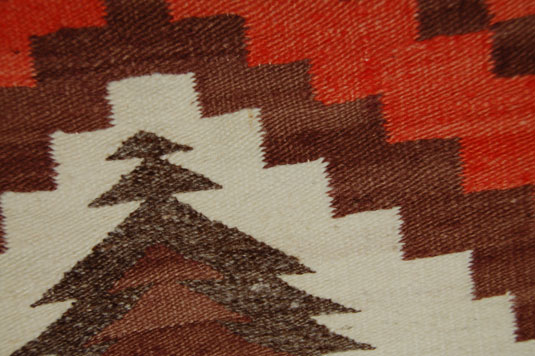Crystal Trading Post Bordered Navajo Rug [SOLD]
+ Add to my watchlist Forward to Friend
- Category: Navajo Textiles
- Origin: Diné of the Navajo Nation
- Medium: wool
- Size: 32” x 56”
- Item # 25788 SOLD
This Navajo textile floor rug is a typical good quality textile from the 1920s. It has the hallmarks of rugs from Crystal Trading Post area of the Navajo Nation. These are black and white border, serrated diamonds in the center, and a colorful field which is salmon in color with plum-color stepped-pattern bands.
The Spaniards bred two kinds of sheep, the churro and merino. Churro sheep were admirably adapted to sparse countryside and the merino was the finest sheep in the world, so fine it was reserved for the royal family and the nobility and its export from Spain was punishable by death. Based on this, it is obvious that the Spaniards brought churro sheep to the American Southwest in the 1600s and left the merino sheep for royalty. They adapted well to the southwest which had a climate like Spain.
Churro sheep produced fine, long-stapled wool which was well suited to the Navajo hand-spindle. The Navajo acquired their churro sheep by raids on Spanish rancheros and Pueblo Indian farms. They lost all their sheep during their forced relocation and containment at Bosque Redondo in the 1860s. After Bosque Redondo, the government allotted $30,000 to re-stock sheep for the Navajo as they returned to their homeland. The replacement sheep were churro as well.
The United States federal government instituted a program around 1900 to improve the Navajo flocks in which they imported Rambouillet sheep which were descendants of merinos given by the Spanish crown to France who cross bred them with French sheep. The result were sheep with good meat and heavy fleece but with oily wool that was short and curly, not necessarily good for weaving. By the 1920s, the Rambouillet sheep had interbred with the Navajo churro sheep and the mixed-breed wool is what is most evident in rugs of the 1920s-1940s.
Condition: the Crystal Trading Post Bordered Navajo Rug has just been washed and blocked, and had broken warps on one end repaired. It is now in excellent condition and ready for use.
Provenance: from the estate of Harold and Hilda Street, descended through the family.
Recommended Reading:
- Old Navajo Rugs: Their Development from 1900 to 1940 by Marian E. Rodee
- One Hundred Years of Navajo Rugs by Marian E. Rodee. This history of Navajo weaving is a revised, expanded, and updated version of Marian Rodee's 1981 classic book Old Navajo Rugs: Their Development from 1900 to 1940.
Relative Links: Navajo Textiles, Navajo Nation

- Category: Navajo Textiles
- Origin: Diné of the Navajo Nation
- Medium: wool
- Size: 32” x 56”
- Item # 25788 SOLD



